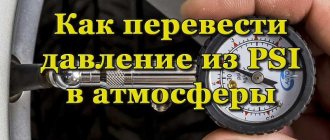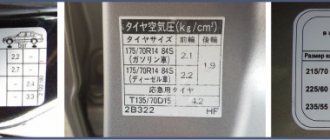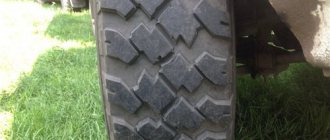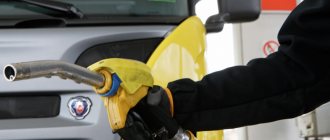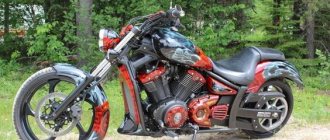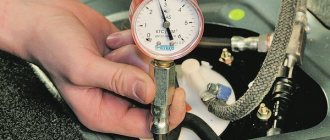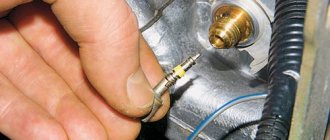One of the main tasks of every car owner is maintaining the correct tire pressure. For this you need very little. You need to arm yourself with a pressure gauge, connect some kind of compressor to the on-board network or to the battery and start pumping the wheel.
At the same time, domestic motorists are accustomed to the fact that pressure in all reference books and operating manuals is always indicated in atmospheres or, in extreme cases, in bars.
But recently the situation has changed. Increasingly, you can find cars whose manufacturer indicates the recommended optimal pressure in a unit of measurement such as PSI.
And here the domestic car enthusiast gets stupefied. After all, everyone is accustomed to the fact that the wheel needs to be pumped to approximately 2 atmospheres. And here the values are many times greater. What it is and how to correctly decipher PSI are the key questions in such situations.
Pressure units
There are several basic options for the units in which tire pressure can be measured.
This is about:
- atmospheres (atm);
- barah (bar);
- pascals (Pa);
- PSI.
One wheel, and so many options for measuring pressure in it.
Motorists are accustomed to the pressure specified in atmospheres or bars being prescribed in technical documentation. It is this that should be maintained in the wheels during vehicle operation, since this is how the automaker calculated that the car will operate in optimal conditions. That is, a better balance between stability, fuel consumption, grip, acceleration and braking dynamics.
It is necessary to adhere to the rule that wheels on the same axle must have the same pressure. Otherwise, controllability will be impaired, uneven tire wear will occur, etc.
In this case, it is allowed for the wheels on different axles to have different pressures. For example, when the trunk is heavily loaded, then the rear wheels can be inflated 0.1-0.2 atm more than the front ones.
It is important to understand the units of measurement and understand how they differ from each other and whether one unit can be converted to another.
Nuances of translation in different units
On the body of many “pure Europeans” the value in psi is already indicated, which the manufacturer targets. For cars of foreign brands that are assembled on our territory, the technical atmosphere indicator applies. So, the approximate ratio will be as follows:
1 Atmosphere contains 14 PSI.
Confusion may arise if the tire or compressor (by the way, which one is better to choose, read here) shows the acceptable values in the BAR. In fact, 1 Bar is approximately equal to 1 atmosphere, so you can use this ratio. For those. For those who are interested in how this all turned out mathematically, here is a simple proof:
- 1 pound contains approximately 0.453 kilograms;
- at the same time, in every square inch there are 6.4516 square centimeters.
We find that one PSI will contain 0.07 kg/cm2, or in each atmosphere, on the contrary, there will be approximately 14 PSI. Despite the fact that such designations may not be entirely familiar to a Russian driver, translation is usually not difficult. The need may arise when purchasing car tires or devices for inflating air. At the same time, Chinese manufacturers often indicate several designations in their products for convenience.
A little about atmospheres
As already mentioned, in most cases the pressure unit is the atmosphere. But not everyone understands what it even means.
The atmosphere is called pressure, which is equal to 1 kilogram per cm2. This is about 0.1 MPa (megaPascal).
In relation to the atmosphere, there are 2 standards:
- Technical. Denoted as at or at. In the technical case, 1 atm corresponds to 735.56 mmHg.
- Physical. This is already atm or atm. The difference is small since it is 760 mmHg.
In relation to the pressure in the wheels of a car, it is customary to equate the technical and physical atmosphere.
Do not forget that the difference between 1 atm and 1 bar is also insignificant. The latter corresponds to 750.06 mm. mercury column. Because of this, 1 atm = 1 bar. For motorists, the slight error between two units of pressure measurement is not taken into account. This will not affect the condition of the tire in any way.
FAQ
1 bar how many atmospheres?
To get an approximate result of how many atmospheres are in one bar, you need to divide the pressure value by a factor of 1.013. That is, 1 bar is 0.98 atmospheres
. Therefore, when converting one unit of measurement of small pressure (up to 10 bar) to another, it is generally accepted that 1 bar ≈ 1 atm. This ratio in calculations will give an error not exceeding 2%.
1 MPa is how much bar?
To find out how much bar is in one megapascal, it is enough to multiply the pressure value expressed in MPa by 10. That is, 1 MPa = 10 bar
.
1 MPa is how many KGS cm2?
To convert one MegaPascal to a pressure value expressed in kilogram-force per square centimeter, it is enough to multiply the MPa value by 10.197. Thus 1 MPa = 10.197 kgf/m²
.
Getting to know PSI
Now we should talk about what kind of unit of measurement PSI is.
In relation to tires, PSI can also often mean pressure. This unit of measurement is widely used in the USA and other countries where the inch system of measurements is used.
If you ask a person who lives according to the inch (English) system what the atmosphere in tires means, he will answer approximately the same as our person about PSI. Surely nothing at all, since such units, which are familiar to us, are not used there. This means there is no need to worry about this. We'll fix everything.
When dealing with the issue of PSI, it is important to note the following.
1 PSI unit corresponds to 51.715 mm. mercury column. This is approximately 14 times less than in the case of the atmosphere. Measured in pounds per square inch.
And it is quite natural to ask how much PSI should be to create the correct pressure in the tires of any car where other units of measurement are used.
In the case of domestic motorists, there is a need to convert one unit to another. This will go a long way toward understanding how much PSI your car's tires should actually have.
How to use an online calculator?
Description of the calculator functionality
- Left column of the calculator . Contains a selection of initial values. A precise technical is displayed below each column .
- Right column of the calculator. Contains the final translation value. Under each column there is a detailed description of the final transfer amount.
- Getting results. To convert MPa to pascals, enter the values of the original value. The online calculator will quickly translate the original data.
Please note the rounding feature. When translating, whole numbers are treated as exact up to 15 digits .
The allowed number of digits after the decimal point is 10 units.
To convert extremely large and small numbers, a separate concept is used: computer exponential notation. Using this method, it is possible to write numbers with high concomitant abbreviations.
Who is the online calculator designed for?
- For specialists who conduct scientific research. You can easily convert, for example, a bar to a torr.
- For vehicle owners. Very often it is necessary, for example, to convert MPa to bars . This data is used to analyze the condition of the fuel line, as well as to check the nominal tire pressure of the vehicle.
- Car owners use a calculator when converting a single value into MPa in the process of filling car parts with freon.
Let's summarize
We need to say a few words about the “foreigners” in our table - the “psi” and “psf” measurements.
Pounds scuare feet (psf) are pounds per square foot; they, like “psi” (pounds scuare inches) - pounds per square inch, can measure pressure when described in English-language sources. So, for example, one kgf/cm2 is approximately equal to 14 psi.
And this video clearly illustrates with a concrete example how to convert one unit to another within the SI system:
Having delved into the topic, you will soon learn how to convert not only MPa to kilogram s/cm2, but also make the reverse conversion, i.e. Convert kilogram s/cm2 to MPa.
5 1 vote
Article rating
Normal atmospheric pressure for humans
Psi in atmosphere
Normal atmospheric pressure is 760 mmHg or 101,325 Pa at 0℃ at sea level (45º latitude). At the same time, the atmosphere acts on every square centimeter of the earth's surface with a force of 1.033 kg. A column of mercury 760 mm high balances the mass of this air column.
The figure of 760 mm was also determined by Torricelli during the experiment. He also noticed that when a flask is filled with mercury, there is a void at the top. Subsequently, this phenomenon was called the “Torricelli void.” Then the scientist did not yet know that during his experiment he created a vacuum - that is, a space free from any substances.
At a standard pressure of 760 mmHg a person feels most comfortable. If we take into account the previous data, then the air presses on a person with a force of about 16 tons. Why then do we not feel this pressure?
The fact is that there is also pressure inside the body. Not only people, but also representatives of the animal world have adapted to atmospheric pressure. Each organ was formed and developed under the influence of this force. When the atmosphere acts on a body, this force is distributed evenly over the entire surface. Thus, the pressure is balanced and we do not feel it.
Atmospheric pressure map of Russia
The atmospheric pressure norm should not be confused with the climate norm. Each region has its own standards for a certain time of year. For example, residents of Vladivostok are lucky, since the average annual atmospheric pressure there is almost equal to the norm - 761 mm Hg.
And in settlements located in mountainous areas (for example, in Tibet), the pressure is much lower - 413 mm Hg. This is due to the altitude of about 5000 m.
How can weather-dependent people protect themselves from pressure changes?
The mercury pressure (the normal value can suddenly change to high or low several times during the day) cannot be adjusted, therefore
People dependent on weather conditions are advised to adhere to the following rules:
- get examined by a specialist. An examination by a doctor will reveal additional reasons for the body’s sensitivity to changes in atmospheric pressure (hidden chronic pathologies, hormonal imbalance or general weakening of the immune system);
- undergo treatment. Timely stop the exacerbation of chronic diseases under the supervision of a specialist;
- tracking weather forecasts or purchasing a home barometer. This method will allow you to prepare in advance for upcoming changes in atmospheric pressure and take preventive measures;
- ensure a good night's rest. The duration of night sleep should be at least 8 hours. It is also recommended to get up no later than 7 a.m. and go to bed before 10 a.m. Adequate sleep will allow the body to fully recover and more easily tolerate a decrease/increase in blood pressure;
- maintain a proper diet. Food should be varied and contain sufficient amounts of vitamins and minerals. Adequate nutrition will strengthen your immune system and make you less susceptible to fluctuations in atmospheric pressure. You should also exclude heavy and unhealthy foods from the menu, do not overeat before bed and do not allow long breaks between meals. This will avoid the development of pathologies in the gastrointestinal tract or exacerbation of chronic diseases that contribute to a decrease in immunity;
- Take daily walks in the fresh air (in any weather). Fresh air normalizes metabolic processes in the body, increases the amount of oxygen in the blood and helps strengthen the immune system;
- perform daily physical activity. If you have diseases that limit physical activity, a set of exercises is compiled in a physical therapy room under the supervision of a specialist. Exercises allow you to normalize the activity of the cardiovascular system, activate blood circulation and the functioning of joints. As a result, symptoms from fluctuations in atmospheric pressure will be less pronounced;
- adjust your daily routine. If possible, then during the period of the cyclone or anticyclone, postpone physical and mental work and devote more time to rest;
- take a contrast shower in the morning. The procedure allows you to normalize the condition of blood vessels, activates metabolic processes and strengthens the immune system;
- use vitamin complexes and immunomodulators. These drugs can further enhance the body’s defenses. The products are especially recommended for busy people who do not have the opportunity to take daily walks, exercise and other methods to strengthen the immune system;
- to refuse from bad habits. Nicotine and alcohol have a negative effect on blood vessels, gastrointestinal tract organs and aggravate the deterioration of the condition during changes in atmospheric pressure;
- taking medications. If you have chronic diseases, prepare the necessary medications (ointments for joint pain, tablets for headaches, or medications to lower/increase blood pressure). The type of drugs depends on the type of disease and is prescribed by a doctor;
- take sedatives. During periods of pressure fluctuations, you need to take sedative medications and drink soothing herbal decoctions. They are involved in normalizing blood pressure, eliminating nervous tension and helping to relieve symptoms from pressure changes.
| During an anticyclone | During a cyclone | ||
| To eliminate headaches | Paracetamol | Painkillers and tonics | Caffeamine |
| Analgin | Askofen | ||
| Ibuprofen | Citramon | ||
| To normalize the activity of nerve cells | Persen | To normalize blood pressure | Heptamine |
| Sedariston | Apilak | ||
| Novopassit | Dopamine | ||
| To normalize joint activity | Voltaren gel | To normalize breathing | Ketoprofen |
| Fastum gel | Intal | ||
| Nurofen gel | Cromolyn |
It is recommended to combine medication use with preventive measures, then changes in atmospheric pressure will not affect the general condition even in weather-sensitive people.
The normal blood pressure reading is 760 mm Hg. Art. But depending on the climate zone, the value changes up or down. A person adapts to the indicator that prevails in the region of residence
It is important that a sharp increase or decrease in mercury readings is the main cause of sudden changes in blood pressure
0…1,000 psi to bar Conversion
psi pressure related products
- Contaminated groundwater submersible plastic body 5 psi pressure transducer & display
- Low operating temperature plus/minus 1 psi pressure transmitter
- 300 F protected 100 psi pressure transmitter
- Dust ATEX approved 2 psi pressure transmitter
Request product info for a psi unit range pressure measurement device.
Enter a pressure in psi below to convert it to the equivalent pressure in bar.
Sorry, a graphic could not be displayed here, because your browser does not support HTML5 Canvas. bar pressure related products
- Hydraulic puller-tensioner bar pressure to kilonewton load HMI display & logger
- Dirty water, sludge & sewerage tank level 400 mbar pressure sensor
- 200 bar pressure sensor to interface with Arduino board
- Anaerobic digestion methane gas 2bar pressure transmitter
Request product info for a bar unit range pressure measurement device.
Choose a value between 0 and 1000 psi from the pressure conversion table below, to obtain the converted value in bar.
Spacesuits
NASA's reusable transport spacecraft Atlantis is on display at the Kennedy Space Center.
Pilots and astronauts have to work in low-pressure environments, so they wear spacesuits that compensate for the low pressure environment. Space suits completely protect a person from the environment. They are used in space. Altitude-compensation suits are used by pilots at high altitudes to help the pilot breathe and counteract low barometric pressure.
Mercury, water, wine...
The earth is surrounded by a layer of air consisting of a mixture of gases. This air layer is called the atmosphere. Objects on Earth are subject to atmospheric influences.
E. Toricelli (1608 - 1647) was the first to come up with a method for measuring it.
3 years after the mercury barometer was made, the great B. Pascal designed a water barometer. The scientist repeated the experiment, replacing the mercury with water. But this seemed to him not enough. He continued experiments with oil, wine and... who knows how many liquids leaked during the research!
There are many units for measuring pressure:
- Pa - pascal (and its derivatives: MPa (megapascal), kPa (kilopascal)
- bar
- atmosphere
- millimeters of mercury
- inches of mercury
- millimeters of water column
- inches of water
- kilogram force per cm2 (kgf/cm2)
- psf
- psi
- meters of water column
Pascal
How to convert psi pressure into atmospheres
So, pascal (Pa) is a measure of pressure, mechanical stress, elastic modulus and some other characteristics used in technology. A pressure of 1 pascal is created by a force of 1 newton, uniformly distributed over an area of 1 square meter perpendicular to the direction of its action (1 Pa = 1 N/m2). Remembering that 1 N = 1 kg∙m/s 2, we can express the pascal in terms of SI base units: 1 Pa = 1 kg/(m∙s 2).
Pressure is a scalar quantity; it characterizes the result of the action of an external force on a surface distributed over its area. Let's explain this with an example: imagine a person who first moves through loose snow on skis, and then takes them off and falls deep into a snowdrift. In the first case, the force - the weight of a person - is evenly distributed over a relatively large surface of the skis, in the other - only over the area of the foot, which leads to an increase in pressure, and consequently to subsidence of the snow.
External forces acting on a body tend to shift the position of the particles of which it consists. In response to this, internal forces will arise within the body that prevent displacement. The measure of the result of their action is called mechanical stress, which is also expressed in pascals.
Pressure in geology
Quartz crystal illuminated by laser pointer
Pressure is an important concept in geology. Without pressure, the formation of gemstones, both natural and artificial, is impossible
High pressure and high temperature are also necessary for the formation of oil from the remains of plants and animals. Unlike gems, which primarily form in rocks, oil forms at the bottom of rivers, lakes, or seas. Over time, more and more sand accumulates over these remains. The weight of water and sand presses on the remains of animal and plant organisms. Over time, this organic material sinks deeper and deeper into the earth, reaching several kilometers below the earth's surface. The temperature increases by 25 °C for every kilometer below the earth's surface, so at a depth of several kilometers the temperature reaches 50–80 °C. Depending on the temperature and temperature difference in the formation environment, natural gas may form instead of oil.
Diamond tools
Natural gemstones
The formation of gemstones is not always the same, but pressure is one of the main components of the process. For example, diamonds are formed in the Earth's mantle, under conditions of high pressure and high temperature. During volcanic eruptions, diamonds move to the upper layers of the Earth's surface thanks to magma. Some diamonds fall to Earth from meteorites, and scientists believe they formed on planets similar to Earth.
Synthetic gemstones
The production of synthetic gemstones began in the 1950s and has been gaining popularity recently. Some buyers prefer natural gemstones, but artificial stones are becoming more and more popular due to their low price and lack of hassles associated with mining natural gemstones. Thus, many buyers choose synthetic gemstones because their extraction and sale is not associated with human rights violations, child labor and the financing of wars and armed conflicts.
One of the technologies for growing diamonds in laboratory conditions is the method of growing crystals at high pressure and high temperature. In special devices, carbon is heated to 1000 °C and subjected to pressure of about 5 gigapascals. Typically, a small diamond is used as the seed crystal, and graphite is used for the carbon base. From it a new diamond grows. This is the most common method of growing diamonds, especially as gemstones, due to its low cost. The properties of diamonds grown in this way are the same or better than those of natural stones. The quality of synthetic diamonds depends on the method used to grow them. Compared to natural diamonds, which are often clear, most man-made diamonds are colored.
Due to their hardness, diamonds are widely used in manufacturing. In addition, their high thermal conductivity, optical properties and resistance to alkalis and acids are valued. Cutting tools are often coated with diamond dust, which is also used in abrasives and materials. Most of the diamonds in production are of artificial origin due to the low price and because the demand for such diamonds exceeds the ability to mine them in nature.
Some companies offer services for creating memorial diamonds from the ashes of the deceased. To do this, after cremation, the ashes are refined until carbon is obtained, and then a diamond is grown from it. Manufacturers advertise these diamonds as mementos of the departed, and their services are popular, especially in countries with large percentages of wealthy citizens, such as the United States and Japan.
Method of growing crystals at high pressure and high temperature
The method of growing crystals under high pressure and high temperature is mainly used to synthesize diamonds, but recently this method has been used to improve natural diamonds or change their color. Various presses are used to artificially grow diamonds. The most expensive to maintain and the most complex of them is the cubic press. It is used primarily to enhance or change the color of natural diamonds. Diamonds grow in the press at a rate of approximately 0.5 carats per day.
Author of the article: Kateryna Yuri
Unit Converter articles were edited and illustrated by Anatoly Zolotkov
Let's summarize
We need to say a few words about the “foreigners” in our table - the “psi” and “psf” measurements.
Pounds scuare feet (psf) are pounds per square foot; they, like “psi” (pounds scuare inches) - pounds per square inch, can measure pressure when described in English-language sources. So, for example, one kgf/cm2 is approximately equal to 14 psi.
And this video clearly illustrates with a concrete example how to convert one unit to another within the SI system:
Having delved into the topic, you will soon learn how to convert not only MPa to kilogram s/cm2, but also make the reverse conversion, i.e. Convert kilogram s/cm2 to MPa.
About heating boilers
To be honest, I started all this reasoning for the sake of a heating boiler; it is in modern models that require pressure in their system that have indicators on the side or on a digital display.
“Why is it needed?” - you ask. YES, it’s all simple guys, in modern boilers there is a pump that pushes water through the system, and the greater the pressure, the easier it is for it to do this! That is why if it drops to a minimum level (usually below 0.9 BAR), the boiler automatically turns off and will not work.
That is, in order for it to function normally, it needs to monitor the “bars”. However, it’s also not worth “borscht” - if you increase the pressure above 2.7 BAR, the boiler will also turn off (the protection will work), because the heat exchangers are made of copper or brass - and this is a soft material, it can simply break! Therefore, excess pressure relief systems have been installed.
That is why it is mandatory to bring out a sensor with an indicator.
Wow, this was a great article, I tried to cover the topic as much as possible. I think it worked.
Pressure units MPa kPa Bar PSI Atm kgf/cm 2
Coefficients (ratios) for converting pressure units.
| Unit | Convert to | Coefficient |
| 1 kilogram force per centimeter 2 (kgf/cm 2) | bar | 0,980665 |
| 1 kilogram force per centimeter 2 (kgf/cm 2) | MPa | 0,0980665 |
| 1 kilogram force per centimeter 2 (kgf/cm 2) | kPa | 98,0665 |
| 1 kilogram force per centimeter 2 (kgf/cm 2) | PSI | 14,22334 |
| 1 pound per inch 2 (PSI) | kgf/cm 2 | 0,07030696 |
| 1 pound per inch 2 (PSI) | bar | 0,06894757 |
| 1 bar | PSI | 14,50377 |
| 1 pound per inch 2 (PSI) | MPa | 0,006894757 |
| 1 megapascal (MPa) | PSI | 145,035 |
| 1 kilopascal (kPa) | bar | 0,01 |
| 1 bar | kPa | 100 |
| 1 megapascal (MPa) | bar | 10 |
| 1 bar | MPa | 0,1 |
| 1 technical atmosphere (atm) | MPa | 0.0980665 |
| 1 technical atmosphere (atm) | bar | 0,980665 |
| 1 megapascal (MPa) | atm | 9,869233 |
PSI Conformity to Metric Pressure Units
| PSI Pounds per inch 2 | kPa Kilopascal | MPa Megapascal | Bar Bar | Standard solutions |
| 10 | 68,9 | 0,07 | 0,7 |
industrial hoses Polymer tubes polymer tubes Main types of pneumatic tubes pneumatic tubes Measurement and recording systems measuring systems |
| 20 | 137,9 | 0,14 | 1,4 | |
| 30 | 206,8 | 0,21 | 2,1 | |
| 40 | 275,8 | 0,28 | 2,8 | |
| 50 | 344,7 | 0,34 | 3,4 | |
| 60 | 413,7 | 0,41 | 4,1 | |
| 70 | 482,6 | 0,48 | 4,8 | |
| 80 | 551,6 | 0,55 | 5,5 | |
| 90 | 620,5 | 0,62 | 6,2 | |
| 100 | 689 | 0,7 | 6,9 | |
| 200 | 1,379 | 1,4 | 13,8 | |
| 300 | 2,068 | 2,1 | 20,7 | |
| 400 | 2,758 | 2,8 | 27,6 | |
| 500 | 3,447 | 3,4 | 34,5 | |
| 600 | 4,137 | 4,1 | 41,4 | |
| 700 | 4,826 | 4,8 | 48,3 | |
| 800 | 5,516 | 5,5 | 55,2 |
|
| 900 | 6,205 | 6,2 | 62,1 | |
| 1000 | 6,895 | 6,9 | 68,9 | |
| 2000 | 13,790 | 13,8 | 137,9 | |
| 3000 | 20,684 | 20,7 | 206,8 | |
| 4000 | 27,579 | 27,6 | 275,8 | |
| 5000 | 34,474 | 34,5 | 344,7 | |
| 6000 | 41,369 | 41,4 | 413,7 | |
| 7000 | 48,263 | 48,3 | 482,6 | |
| 8000 | 55,158 | 55,2 | 551,6 | |
| 9000 | 62,053 | 62,1 | 620,5 |
|
| 10000 | 68,948 | 68,9 | 689 | |
| 20000 | 137,895 | 137,9 | 1379 | |
| 30000 | 206,843 | 206,8 | 2068 | |
| 40000 | 275,790 | 275,8 | 2758 |
At what pressure will coffee help?
Values have been rounded for practical purposes
Correspondence of metric units of pressure to English PSI
| kPa Kilopascals | MPa Megapascals | Bar Bar | PSI Pounds per inch 2 |
| 100 | 0,1 | 1 | 14,5 |
| 200 | 0,2 | 2 | 29 |
| 300 | 0,3 | 3 | 43,5 |
| 400 | 0,4 | 4 | 58 |
| 500 | 0,5 | 5 | 72,5 |
| 600 | 0,6 | 6 | 87 |
| 700 | 0,7 | 7 | 101,5 |
| 800 | 0,8 | 8 | 116 |
| 900 | 0,9 | 9 | 130,5 |
| 1000 | 1,0 | 10 | 145 |
| 2000 | 2,0 | 20 | 290 |
| 3000 | 3,0 | 30 | 435 |
| 4000 | 4,0 | 40 | 580 |
| 5000 | 5,0 | 50 | 725 |
| 6000 | 6,0 | 60 | 870 |
| 7000 | 7,0 | 70 | 1015 |
| 8000 | 8,0 | 80 | 1160 |
| 9000 | 9,0 | 90 | 1305 |
| 10000 | 1.0 | 100 | 1450 |
| 20000 | 2,0 | 200 | 2901 |
| 30000 | 3,0 | 300 | 4351 |
| 40000 | 4,0 | 400 | 5802 |
| 50000 | 5,0 | 500 | 7252 |
| 60000 | 6,0 | 600 | 8702 |
| 70000 | 7,0 | 700 | 10153 |
| 80000 | 8,0 | 800 | 11603 |
| 90000 | 9,0 | 900 | 13053 |
| 100000 | 100 | 1 000 | 14504 |
| 200000 | 200 | 2 000 | 29008 |
| 300000 | 300 | 3 000 | 43511 |
Values have been rounded for practical purposes
Source
Watch water resistance standards
There are many different standards that determine the water resistance of watches and other electronic devices (such as phones). Waterproof watches are very popular among tourists, climbers and extreme sports enthusiasts.
Watch water resistance standard ISO 2281 (GOST 29330)
This standard was adopted in 1990 to standardize the water resistance of watches. It describes the procedure for checking the water resistance of a watch during testing. The standard specifies the requirements for water or air pressure at which the watch must maintain its tightness and performance. However, the standard states that it can be carried out selectively. This means that not all watches produced according to this standard undergo mandatory water resistance testing - the manufacturer can selectively check individual pieces. This standard is used for watches that are not specifically designed for diving or swimming, but only for watches for daily use with possible short-term immersion in water.
Testing a watch to this water resistance standard consists of the following steps:
- Immerse the watch in water to a depth of 10 cm for one hour.
- Immerse the watch in water to a depth of 10 cm with a water pressure of 5 N (newtons) perpendicular to the buttons or to the crown for 10 minutes.
- Immerse the watch in water to a depth of 10 cm and change the temperature between 40°C, 20°C and again 40°C. The watch stays at each temperature for five minutes, the transition between temperatures is no more than five minutes.
- Immersion of watches in water in a pressure chamber and exposure of them to their nominal pressure for which they are designed for 1 hour. Condensation inside the watch and water penetration into the case are not allowed.
- Checking the watch with 2 atm above the rated pressure.
Well, additional checks not directly related to the water resistance of the watch:
- The watch must not show streamlining exceeding 50 μg/min
- No strap test required
- No corrosion test required
- No negative pressure test required
- No magnetic field or shock test required
ISO 6425 standard - diving and diving watches
This standard was developed and adopted in 1996, and is intended specifically for watches that have increased requirements for water resistance, such as watches for diving, spearfishing and other types of underwater work.
All watches manufactured according to ISO 6425 are required to be tested for water resistance. That is, unlike the ISO 2281 standard, where only individual watches are tested for water resistance, in the ISO 6425 standard, absolutely all watches are tested at the factory before sale.
Moreover, the check is also carried out in excess of the calculated indicators by 25%. That is, a watch designed for diving up to 100 meters will be tested at the same pressure as at a depth of 125 meters.
According to the ISO 6425 standard, all watches must pass the following water resistance tests: Prolonged exposure to water. The watch is immersed in water to a depth of 30 cm for 50 hours. Water temperature can vary from 18°C to 25°C. All mechanisms must continue to function, and no condensation should appear inside the watch. Check for condensation in the watch. The watch heats up to a temperature of 40°C - 45°C. After this, cold water is poured onto the watch glass for 1 minute. Watches that develop condensation on the glass on the inside surface of the glass should be destroyed. Resistance of crowns and pushers to increased water pressure. The watch is placed in water and pressurized in water 25% above its water resistance rating. Within 10 minutes in such conditions, the watch should remain sealed. Long-term exposure to water under pressure exceeding the design pressure by 25% for two hours. The watch must continue to work and remain sealed. Condensation should not form on the glass.
Immersion in water to a depth of 30 cm, changing the water temperature from 40°C to 5°C and again 40°C. The transition time from one dive to another should not exceed 1 minute.
Exceeding the design pressure by 25% provides a safety margin to prevent getting wet when there is a dynamic increase in pressure or a change in water density, for example, sea water is 2 - 5% denser than fresh water.
Watches that have passed ISO 6425 testing are marked with the inscription DIVER'S WATCH L M. The letter L indicates the immersion depth in meters guaranteed by the manufacturer.
